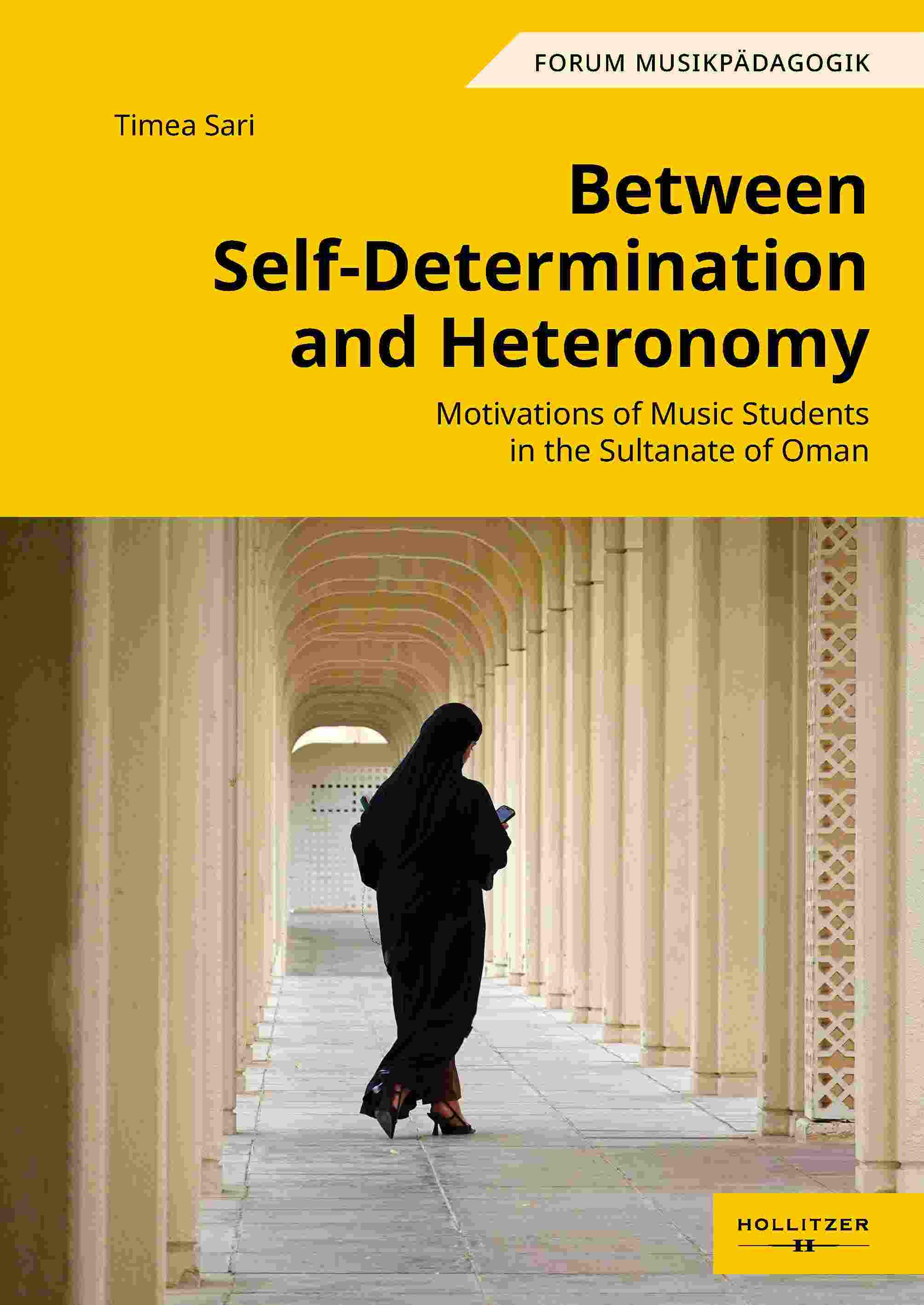
Timea Sari: Between Self-Determination and Heteronomy. Motivations of Music Students in the Sultanate of Oman, Wien: Hollitzer Verlag, 2025 (Forum Musikpädagogik Band 164, Augsburger Schriften), 348 Seiten, 17 x 24 cm, Englisch, Softcover
ISBN 978-3-99094-598-8 (pbk) € 45,00
ISBN 978-3-99094-601-5 (pdf) € 44,99
Between Self-Determination and Heteronomy
Motivations of Music Students in the Sultanate of Oman
In the past fifty years, Oman has undergone significant political, economic, and social transformations, with music playing a key role in the country’s cultural development. The establishment of institutions promoting music education and public musical participation has resulted in a thriving musical scene. Yet, despite this governmental support, music remains a controversial subject within Omani society, shaped by traditional Islamic values and prevailing socio-cultural norms.
This study investigates the motivations of Omani music students, exploring their reasons for pursuing a degree in music and their attitudes towards musical learning and practice. Grounded in Self-Determination Theory, the research reveals that while students’ initial decisions to study music were often influenced by extrinsic factors, their engagement with musical learning was characterised by more autonomous forms of motivation. By highlighting the complex and dynamic interplay between personal interests, socio-economic conditions, familial influences, and institutional environments, this study offers a nuanced, context-sensitive account of musical motivation in Oman, contributing to broader discussions on music education, identity, and motivation in non-Western settings.
CONTENTS
List of Tables
List of Figures
1 Introduction
1.1 Purpose of the study
1.2 Mixed methods
1.3 Structure of the thesis
2 Situating the study within the field of comparative music education
2.1 Comparative music education
2.2 Comparative education
2.2.1 Contents of comparative education
2.2.2 Single-country vs. comparative studies
2.2.3 Methodology and methods
2.2.4 The role and position of the researcher in the research process
2.3 Positioning the present study within the research field of comparative music education
3 Context
3.1 The Sultanate of Oman
3.1.1 Early history
3.1.2 Ibadism
3.1.3 The Ya’arubi dynasty
3.1.4 The al-Busa’idi dynasty
3.1.5 The Sultans of Muscat
3.1.6 The reign of Sultan Qaboos
Development of public services
Development of healthcare services
Development of education
Employment
The building of a nation
Demographic composition of the Omani population
Tribal structures in Oman
Religion
Challenges
3.2 Islam and music
3.2.1 Legal (Shari’ah) perspectives
3.2.2 Linguistic aspects
3.2.3 Hierarchy of genres
3.2.4 Major ideological positions
3.2.5 The status of music and musicians within the society
3.3 Music in Oman
3.3.1 Military bands
3.3.2 Royal Bands of Arab Music and Folklore
3.3.3 Royal Oman Symphony Orchestra (ROSO)
3.3.4 Oman Centre for Traditional Music (OCTM)
3.3.5 Royal Opera House Muscat (ROHM)
3.3.6 Music education in the public schools
3.3.7 Challenges
3.4 Department of Music & Musicology
3.4.1 Curriculum
3.4.2 Admission
3.4.3 Students
3.4.4 Faculty
3.4.5 Accreditation of the programme of the DMM
4 Theoretical frameworks
4.1 Motivation
4.2 Self-Determination Theory
4.2.1 SDT’s organismic dialectic approach
4.2.2 Basic psychological needs
4.2.3 Cognitive Evaluation Theory (CET)
4.2.4 Organismic Integration Theory (OIT)
4.2.5 Causality Orientations Theory (COT)
4.2.6 Basic Psychological Needs Theory (BPNT)
4.2.7 Goal Contents Theory (GCT)
4.2.8 Relationships Motivation Theory (RMT)
4.3 SDT in music education research
4.3.1 SDT research with children and adolescents
4.3.2 SDT research with music students
5 Phase One
5.1 Method
5.1.1 Participant information
5.1.2 Academic motivation: Academic Motivation Scale (AMS)
5.1.3 Perceived competence: Perceived Competence Scale (PCS)
5.1.4 Practice motivation: Self-Regulation Questionnaire – Practice (SRQ-P)
5.1.5 Perceived autonomy support: Learning Climate Questionnaire (LCQ)
5.1.6 Translation of the questionnaire
5.1.7 Study procedures
5.1.8 Participants
5.1.9 Data analysis
5.2 Results
5.2.1 Academic Motivation Scale (AMS C-28)
5.2.2 Self-Regulation Questionnaire – Practice (SRQ-P)
5.2.3 Perceived Competence Scale (PCS) and Learning Climate Questionnaire (LCQ)
5.2.4 Multiple hierarchical regression analyses
5.3 Discussion
6 Phase Two
6.1 Method
6.1.1 Meta-theoretical positioning
6.1.2 Recruitment, participants, and data collection
6.1.3 Interviews
6.1.4 Analysis
6.1.5 Reflexivity
6.2 Results
6.2.1 “You get a degree, you get a job, you get money”
6.2.2 “I have to love what I study”
6.2.3 “You have to be strong” – to do music in Oman
6.2.4 “Real” music education
6.2.5 “It is basically practice”
6.2.6 “Teachers play a very important role”
6.2.7 I know what music is about, not like others
6.3 Discussion
7 General Discussion
8 Strengths and limitations
9 Conclusion
References



